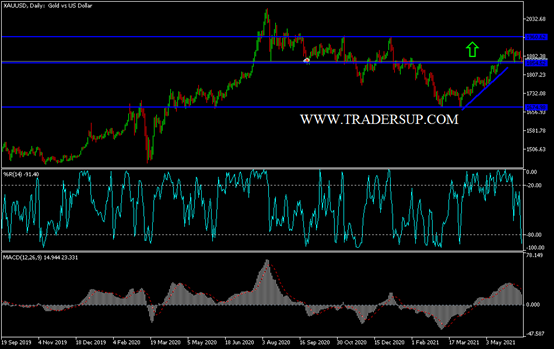By the end of last week's trading, the bulls tried to stabilize the price of gold around and above the psychological resistance of 1900 dollars an ounce. With the increasing bearish momentum, the price of gold moved to the level of 1875 dollars an ounce before closing the week's trading, stable around the level of 1877 dollars an ounce.
The price of gold is trying hard to increase despite the high inflation in the USA which is usually bullish for the metals market. The price of gold recorded a weekly loss of 0.9%, bringing its annual loss since the start of 2021 to date to more than 1%. As for the price of silver, the sister commodity to gold, it ends the week's trading above the $28 level. The white metal posted a weekly boost of about 0.8%, taking its 2021 rally above 6%.
The yellow metal was mostly hit by rising expectations about the future of the US Federal Reserve's tightening policy. The US Dollar Index (DXY), which measures the performance of the US currency against a basket of six major rival currencies, rose to 90.60. The index will register a weekly increase of 0.5%, allowing DXY to enter positive territory. In general, a stronger profit for the US dollar is bad for dollar-priced commodities because it makes them more expensive to buy for foreign investors.
US bond yields were mixed by the end of last week's trading, as the 10-year bond yield fell to 1.455%. One-year US Treasury yields rose to 0.51%, while 30-year yields fell to 2.142%. Higher Treasury yields are bearish for gold because they raise the opportunity cost of holding non-yielding bullion.
Last week, it was announced that the annual inflation rate in the US had recorded 5%, the highest level since September 2008. Despite rising consumer prices, gold is not responding as gold experts had expected. Investors generally flock to safe haven assets, such as precious metals, in an inflationary environment. However, analysts stress that the Fed's response to this high inflation is good for gold because the Fed is likely to keep US interest rates at historical lows. Also, if the central bank refuses to act, it may scare away some investors and force traders to invest in gold.
Relative to the prices of other metallic commodities, copper futures contracts rose to 4.527 dollars per pound. Platinum futures rose to $1,150.30 an ounce. Palladium futures rose to $2781.50 an ounce.
At the end of last week's trading, US stocks showed no direction for most of the trading day but managed to end the session mostly higher. The S&P 500 reached a new record closing level, while the Nasdaq rose to its best closing level in more than a month. The major US stock indices moved to the upside. The Dow Jones rose 13.36 points, or less than a tenth of a percent, to 34479.60 points. The Nasdaq rose 49.09 points, or 0.4 percent, to 14069.42, and the Standard & Poor's 500 index rose 8.26 points, or 0.2 percent, to 4247.44.
During the week, the major US stock indices turned mixed performance. The Nasdaq jumped 1.8 percent and the Standard & Poor's rose 0.4 percent, but the Dow Jones fell 0.8 percent.
All in all, investors seemed reluctant to take significant steps ahead of the Federal Reserve's monetary policy meeting scheduled for this week. The Fed is widely expected to leave its monetary policy unchanged, but investors will be looking for any evidence that the US central bank is considering reducing its asset purchases.
Technical analysis of gold: The recent move in the price of gold downward motivates gold investors to search for new buying levels, and we see that it is better to buy from the support levels of 1859, 1845 and 1830 dollars, respectively. On the other hand, the stronger control of the bulls over the performance again will depend on the return of the movement around and above the psychological resistance of 1900 dollars an ounce. Despite the recent sell-off, the price of gold is still within a clear ascending channel range on the daily chart.'

